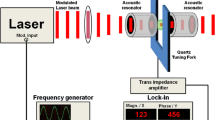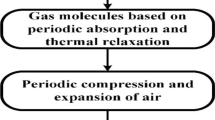Abstract
We report on the use of a radial acoustic resonator to increase the acoustic signal of a quartz enhanced photoacoustic spectroscopy (QEPAS) sensor. This approach is an attractive alternative to usual configurations based on microtube longitudinal resonators since it enables to substantially relax laser beam alignment and positioning and thus paves the way towards more cost-effective industrial production. This new QEPAS configuration is first investigated and designed by finite element simulation. It is then experimentally implemented and characterised by detecting acetylene around 1.5 µm. The combination of the radial acoustic resonator with a custom quartz tuning fork (QTF) leads to a QEPAS sensor with a normalised noise equivalent absorption (NNEA) of \(3.9 \times 10^{-9}\) W cm\(^{-1}\) Hz\(^{-1/2}\) which is close to the performance of state-of-the-art QEPAS sensors based on microtube resonators.









Similar content being viewed by others
References
J. Hodgkinson, R.P. Tatam, Meas. Sci. Technol. 24(1), 012004 (2012)
A.G. Bell, Upon the Production of Sound by Radiant Energy (Gibbson Brothers, 1881)
A. Miklós, P. Hess, Z. Bozóki, Rev. Sci. Instrum. 72(4), 1937–1955 (2001)
V. Koskinen, J. Fonsen, K. Roth, J. Kauppinen. Appl. Phys. B 86(3), 451–454 (2007)
A.A. Kosterev, Y.A. Bakhirkin, R.F. Curl, F.K. Tittel, Opt. Lett. 27(21), 1902–1904 (2002)
M. Duquesnoy. Tuning forks in photoacoustic spectroscopy: comparative study and new developments. PhD thesis, http://www.theses.fr/2021UPASP022/document (2021)
F.G.C. Bijnen, J. Reuss, F.J.M. Harren, Rev. Sci. Instrum. 67(8), 2914–2923 (1996)
V. Zeninari, B. Parvitte, D. Courtois, V.A. Kapitanov, Y.N. Ponomarev, Infared Phys. Technol. 44(4), 253–261 (2003)
N. Petra, J. Zweck, A.A. Kosterev, S.E. Minkoff, D. Thomazy, Appl. Phys. B 94(4), 673–680 (2009)
L. Dong, A.A. Kosterev, D. Thomazy, F.K. Tittel, Appl. Phys. B 100(3), 627–635 (2010)
G. Aoust, Développements de sources infrarouges et de résonateurs en quartz pour la spectroscopie photoacoustique. PhD thesis (2016)
S. Schilt, J.-P. Besson, L. Thévenaz, Appl. Phys. B 82(2), 319–328 (2006)
G. Aoust, R. Levy, B. Verlhac, O. Le Traon, Sens. Actuators A Phys. 243, 134–138 (2016)
P. Patimisco, A. Sampaolo, L. Dong, M. Giglio, G. Scamarcio, F.K. Tittel, V. Spagnolo, Sens. Actuators B Chem. 227, 539–546 (2016)
G. Aoust, R. Levy, B. Verlhac, O. Le Traon, Sens. Actuators A Phys. 269, 569–573 (2018)
H. Zheng, Y. Liu, H. Lin, B. Liu, X. Gu, D. Li, B. Huang, Y. Wu, L. Dong, W. Zhu, J. Tang, H. Guan, H. Lu, Y. Zhong, J. Fang, Y. Luo, J. Zhang, J. Yu, Z. Chen, F.K. Tittel, Photacoustics 17, 100158 (2020)
P. Patimisco, A. Sampaolo, M. Giglio, S. Dello Russo, V. Mackowiak, H. Rossmadl, A. Cable, F.K. Tittel, V. Spagnolo, Opt. Express 27(2), 1401–1415 (2019)
H. Wu, L. Dong, X. Liu, H. Zheng, X. Yin, W. Ma, L. Zhang, W. Yin, S. Jia, Sensors 15(10), 26743–26755 (2015)
X. Yin, L. Dong, H. Wu, H. Zheng, W. Ma, L. Zhang, W. Yin, L. Xiao, S. Jia, F.K. Tittel, Opt. Express 25(26), 32581–32590 (2017)
R. Rousseau, Z. Loghmari, M. Bahriz, K. Chamassi, R. Teissier, A.N. Baranov, A. Vicet, Opt. Express 27(5), 7435–7446 (2019)
T. Ruck, R. Bierl, F.-M. Matysik, Sens. Actuators B Chem. 255, 2462–2471 (2018)
H. Yi, W. Chen, S. Sun, K. Liu, T. Tan, X. Gao, Opt. Express 20(8), 9187–9196 (2012)
M. Duquesnoy, G. Aoust, J.-M. Melkonian, R. Lévy, M. Raybaut, A. Godard, Sensors 19(6), 1362 (2019)
G. Aoust, R. Levy, B. Bourgeteau, O. Le Traon, Patent FR3054666 (2016)
D.A. Russell, Am. J. Phys. 68(12), 1139–1145 (2000)
G. Aoust, R. Levy, M. Raybaut, A. Godard, J.-M. Melkonian, M. Lefebvre, Appl. Phys. B 123(2), 63 (2017)
https://www.open-engineering.com/. Accessed: 2021-04-12
A. Karbach, P. Hess, J. Chem. Phys. 83(3), 1075–1084 (1985)
https://www.comsol.com/blogs/how-to-model-thermoviscous-acoustics-in-comsol-multiphysics/. Accessed: 2021-09-06
T. Iguchi, J. Opt. Soc. Am. B 3(3), 419–423 (1986)
S. Borri, P. Patimisco, I. Galli, D. Mazzotti, G. Giusfredi, N. Akikusa, M. Yamanishi, G. Scamarcio, P. De Natale, V. Spagnolo, Appl. Phys. Lett. 104(9), 091114 (2014)
J. Wojtas, A. Gluszek, A. Hudzikowski, F.K. Tittel, Sensors 17(3), 513 (2017)
H. Lv, H. Zheng, Y. Liu, Z. Yang, Q. Wu, H. Lin, B.A.Z. Montano, W. Zhu, J. Yu, R. Kan et al., Opt. Lett. 46(16), 3917–3920 (2021)
Author information
Authors and Affiliations
Corresponding author
Additional information
Publisher's Note
Springer Nature remains neutral with regard to jurisdictional claims in published maps and institutional affiliations.
Appendix A: Computation of the heat and NNEA
Appendix A: Computation of the heat and NNEA
In photoacoustics, the sensor sensitivity is often characterised by computing the NNEA. In most cases this figure of merit is computed from the gas absorption \(\alpha _{\mathrm {G}}\) and laser mean power \(P_{\mathrm {L}}\) as follows:
with SNR the sensor signal-to-noise ratio and \({\Delta } f\) the measurement bandwidth. This computation method allows to quantify the sensor sensitivity in its actual mode of operation. Also, we observed that the resulting values presented discrepancies for a same detector, mainly depending on the gas used or laser modulation scheme.
In order to compare the detectors on an equal footing, we propose to use a generalised definition of the NNEA so that a given detector will always present the same NNEA. To do so, instead of using directly the gas absorption \(\alpha _{\mathrm {G}}\) and the laser mean power \(P_{\mathrm {L}}\) we use the generated heat inside the medium H. This heat is directly proportional to the acoustic pressure later seen by the detector. It takes into account the gas absorption, the laser power, the overlap between the two and also the gas relaxation rate and detection frequency. The NNEA is now defined as follows:
with H the modulus of its complex form \(\widehat{H}\) defined as:
with \(\tau _{\mathrm {V-T}}\) the gas relaxation rate and \(\omega\) the angular modulation frequency. The first term takes into account gas relaxation rate effect on the signal. As a consequence, the NNEA does not depend on the detected gas, gas matrix and detection wavelength modifying the gas relaxation rate. The second term accounts for the overlap between laser emission and gas absorption, making the NNEA independent of the modulation scheme.
When the laser is modulated in amplitude with a 50% duty cycle one can easily derive \(H=\alpha _{\mathrm {G}} \times P_{\mathrm {L}} /2\), with \(P_{\mathrm {L}}\) the laser mean power before modulation. When using a wavelength modulation, the result is more complex and the overlap should be computed. However, we can derive an approximate value when using a sine modulation and targeting a Lorentzian-like profile of absorption. In this particular case we can derive \(H \thickapprox \alpha _{\mathrm {G}} \times P_{\mathrm {L}} /3\).
We used this approximated expression to compute H in this article. Here, the maximal gas absorption \(\alpha _{\mathrm {G}}\) is equal to 1.84 \(\times \!\) 10\(^{-4}\) cm\(^{-1}\), the laser mean power \(P_{\mathrm {L}}\) is equal to 17 mW, resulting in a heat deposition H of 1.04 \(\times \!\) 10\(^{-6}\) W cm\(^{-1}\).
Rights and permissions
About this article
Cite this article
Duquesnoy, M., Aoust, G., Melkonian, JM. et al. QEPAS sensor using a radial resonator. Appl. Phys. B 127, 150 (2021). https://doi.org/10.1007/s00340-021-07699-2
Received:
Accepted:
Published:
DOI: https://doi.org/10.1007/s00340-021-07699-2




